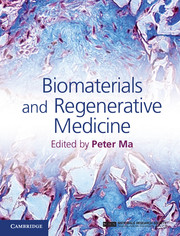Book contents
- Frontmatter
- Contents
- List of contributors
- Preface
- Part I Introduction to stem cells and regenerative medicine
- Part II Porous scaffolds for regenerative medicine
- Part III Hydrogel scaffolds for regenerative medicine
- 14 Polysaccharide hydrogels for regenerative medicine applications
- 15 Functionalized poly(ethylene glycol) hydrogels for controlling stem cell fate
- 16 Fumarate-based hydrogels in regenerative medicine applications
- 17 Hydrogel scaffolds for regenerative medicine
- 18 Microfabricated gels for tissue engineering
- 19 Organ printing
- Part IV Biological factor delivery
- Part V Animal models and clinical applications
- Index
- References
16 - Fumarate-based hydrogels in regenerative medicine applications
from Part III - Hydrogel scaffolds for regenerative medicine
Published online by Cambridge University Press: 05 February 2015
- Frontmatter
- Contents
- List of contributors
- Preface
- Part I Introduction to stem cells and regenerative medicine
- Part II Porous scaffolds for regenerative medicine
- Part III Hydrogel scaffolds for regenerative medicine
- 14 Polysaccharide hydrogels for regenerative medicine applications
- 15 Functionalized poly(ethylene glycol) hydrogels for controlling stem cell fate
- 16 Fumarate-based hydrogels in regenerative medicine applications
- 17 Hydrogel scaffolds for regenerative medicine
- 18 Microfabricated gels for tissue engineering
- 19 Organ printing
- Part IV Biological factor delivery
- Part V Animal models and clinical applications
- Index
- References
Summary
Introduction
Hydrogels are an excellent scaffold structure for numerous applications in tissue engineering and regenerative medicine. In particular, they can be used as cell and drug carriers to deliver such therapeutic components directly and locally [1]. Hydrogels can be injected and crosslinked in situ, reducing the need for risky invasive surgeries [2]. In addition, hydrogels can mimic the natural extracellular matrix (ECM) environment, and allow one to control cellular and tissue functions as well as the transport of nutrients and bioactive molecules [3, 4].
Fumarate-based hydrogels are synthetic polymers, allowing flexible control of physical, mechanical, and degradative properties for a desired application [4]. Fumaric acid, the fundamental component of these hydrogel scaffolds, is an unsaturated organic acid that is commonly found in the human body and can be metabolized through the Krebs cycle [5–7]. Polymer chains that contain fumarate units crosslink easily via the unsaturated double bonds and degrade through hydrolysis of the ester bonds in the fumarate group [6–9]. Furthermore, the biodegradable nature of these hydrogels allows neotissue ingrowth and eliminates the need for further surgery to remove the implanted scaffold [5, 10].
- Type
- Chapter
- Information
- Biomaterials and Regenerative Medicine , pp. 279 - 294Publisher: Cambridge University PressPrint publication year: 2014

